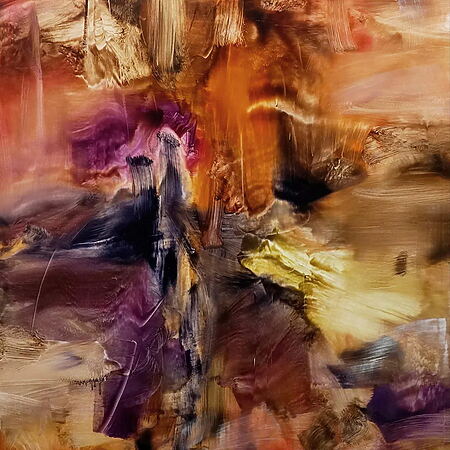A widely held opinion is that art has something to do with skill. This is also true, because if you cannot tell the canvas from the brush, you will have problems producing what is commonly considered "art".
Craftsmanship is required in the sense that a classical education in color theory, drawing, composition, and iconography is helpful. But art has much more to do with seeing – because ultimately it is the recipient, the viewer, who decides what art is (and the market, which is in the hands of the viewers).
Seeing as a physical act
Seeing means that something is perceived with the eyes. This perception is transmitted to the brain in the form of electrical signals through the nerve pathways. There, the signals are translated back into information about brightness, contrast, colour, and, based on their characteristics, into distance and size relations.
The result is the "image" that we see and (thanks to additional nerve pathways, a multitude of information stored in memory, and unconscious cognitive processing) recognize.
Projection of an anamorphic picture: 1) Object to be taken; 2) negative cylinder lens; 3) positive cylinder lens; 4) Spherical lens; 5) recording film

by Werneuchen, via Wikimedia Commons
But what if the information the eye perceives does not match any stored perception, so we "recognise nothing"?
Then it is probably a work of art whose creator not only possessed craftsmanship but also knew how to create illusions. In this context, Anamorphic art can be seen.
Long Tradition – A Historical Retrospective
Anamorphoses are not a 20th-century invention, but rather have a long tradition. Since 1657, images that can only be recognized from a specific angle, which require a mirror, a prism, or a similar distorting tool for recognition, have been referred to as anamorphoses. Of course, there was anamorphic art before that; it just wasn't demonstrably referred to as such.
The word comes from Greek and translates to reshaping. An anamorphic illusion is an image that has been distorted so that it is not recognizable to the naked eye. In 17th-century Italian churches, there are many depictions that can only be recognized from a specific angle or with the help of a mirror or a prism.
The technique (and that's exactly what it is: technical skill) was used to depict the forbidden. Erotic scenes, hidden messages and allusions could thus be accommodated without fear of reprisals. During the Renaissance, anamorphic illusions were used in ceiling paintings to compensate for irregularities in the substrate, providing the viewer with a uniform image.
Challenges from a technical perspective
The creation of anamorphoses requires a deep understanding of perspective and geometry, as the artworks can only be correctly perceived from a specific viewpoint. Artists must make precise calculations to accurately design proportions and distortions.
Nowadays, many creative minds use digital aids such as 3D software to plan complex designs in advance. In addition, choosing the surface plays a crucial role; Anamorphoses come into their own on levels or slightly curved surfaces.
In the Street Art, walls or floors are often used as a canvas to actively involve the audience in the illusion. The size and shape of the surface significantly influence the perception of the work of art.
Optical illusions find a major role in the graffiti scene The street artist Sergio Odeith (@odeithodeith) from Portugal knows how to deceive the senses. The artist's graffiti actually appear as if they were floating in the air.
Old hat?
No, really not! Anamorphic illusions are implemented in contemporary art in a very amazing way. In addition to more or less simple anamorphoses, which are drawn (partly with the help of technical equipment), some artists work with room installations that are very amazing. Individual parts of the installation are attached somewhere in the room, and the viewer sees no connection between the parts.

to illustrate the illustration, created with the BILD-KI ImageFlash
The image that is available looks like a puzzle, the parts of which are lying around scattered. However, if you are in the right place of the room, the individual parts compile into a recognizable image, a text message or a recognizable sculpture .
Anamorphic illusions become truly interesting only when artists work on multiple levels – when text messages contain allusions that the viewer must decipher, when the distorted installations or artworks themselves consist of an illusion or another puzzle.
Impressive works by contemporary artists
In the following videos, you can treat yourself to a sample of astonishing illusions through anamorphic art:
Truly design
The anamorphic Medusa from Truly Design is really impressive . The gigantic portrait painted in the room from Greek mythology is only noticeable from a perspective.
Joseph Egan
The same applies to the typography of Joseph Egan .
What at first glance appears to be chaotic, distorted paintings on the walls and ceiling reveals itself as a perfect typographic construct from a single perspective.
The graphic designer Joseph Egan, based in London, and his fellow students from Chelsea College of Art & Design, created this impressive anamorphotic typography installation as part of its final exam for the Foundation Degree course. At first I had the impression that it was a kind of glass wall with a text sticker.
d'strict
In Seoul, South Korea's largest advertising screen was used for an impressive artistic staging: a huge, moving ocean case appears on it and gives the impression that it is right in front of a mighty wave in the sea. This impressive illusion, created by D'Srict as part of the "Public Media Series" , uses the latest 3D animations and light games to take the viewer into another world.
The technology behind this optical illusion demonstrates innovative creativity in the combination of art and technology. More spectacular illusions are already in the works. Anyone who wants to learn more can find an interview with the animation experts on Bored Panda.
Panya Clark Espinal
Also, the anamorphic street art of the Canadian artist Panya Clark Espinal , which placed optical illusions in Toronto's streets. You can see photos of these extraordinary works at Urban Comfort .
Jonty Hurwitz
Finally, there is Jonty Hurwitz, known as the “Artist Scientist Archetype ,” as he likes to call himself. With this artist, the artworks only reveal themselves in the reflection of cylinders. In various works, he varies the principle of his anamorphic sculptures , staging them either individually or as part of larger works in different environments.
His current work also includes “Yogi Blanker” , which - implemented by photographs in prints - can be obtained Saatchi Gallery You can find out more about his works at Art School Vets .
Thomas Medicus
The impressive, huge glass cubes by the Austrian artist Thomas Medicus also attract the views of the viewers with their unusual aesthetics and innovative technology. Each cube is a masterpiece for itself and reveals a new, distinctive perspective at every turn. As if by magic, a previously coherent picture is dissolved and passes into a completely different motif.
The “Emergence Lab” is a manual anamorphological sculpture by the artist:
This reciprocal relationship between the object and the viewer creates a unique experience. Thomas Medicus masterfully plays with light and transparency. The different images that emerge with changes in the viewing angle not only reflect the surfaces of the glass but also the perception of the viewer themselves.
Thus, the glass cubes become a symbol of the complexity of reality and the diversity of human experiences. Through this interactivity, the artwork becomes an experience that inspires wonder and contemplation.
Drawing Anamorphoses with Yadegar Asisi
The creation of anamorphosis requires well -founded skills in the perspective representation. Yadegar Asisi devoted himself to this task for an exhibition
What does the future look like?
The creative potential of the anamorphoses is not yet exhausted due to technological progress. Augmented Reality (AR) and Virtual Reality (VR) open up new spaces in which anamorphic representations can be experienced not only on physical surfaces, but also in virtual rooms.
These technologies enable artists and designers to create immersive experiences, which are increasingly being applied in the gaming and film industries. Illusory spaces are created here, dynamically altering the audience's perception and creating emotional intensity.
Thus, anamorphoses could play a significant role in everyday life, whether in interactive experiences or as creative elements in digital media.
Make artistic illusions yourself
If you have really gotten a taste for it and some artistic blood flows in you, then you might now feel like trying your hand at an anamorphic illusion yourself. Then these video tutorials will surely help you:
Have fun trying it out!

Owner and Managing Director of Kunstplaza. Publicist, editor, and passionate blogger in the field of art, design, and creativity since 2011. Successful completion of a degree in web design as part of a university program (2008). Further development of creativity techniques through courses in free drawing, expressive painting, and theater/acting. Profound knowledge of the art market through many years of journalistic research and numerous collaborations with actors/institutions from art and culture.

















